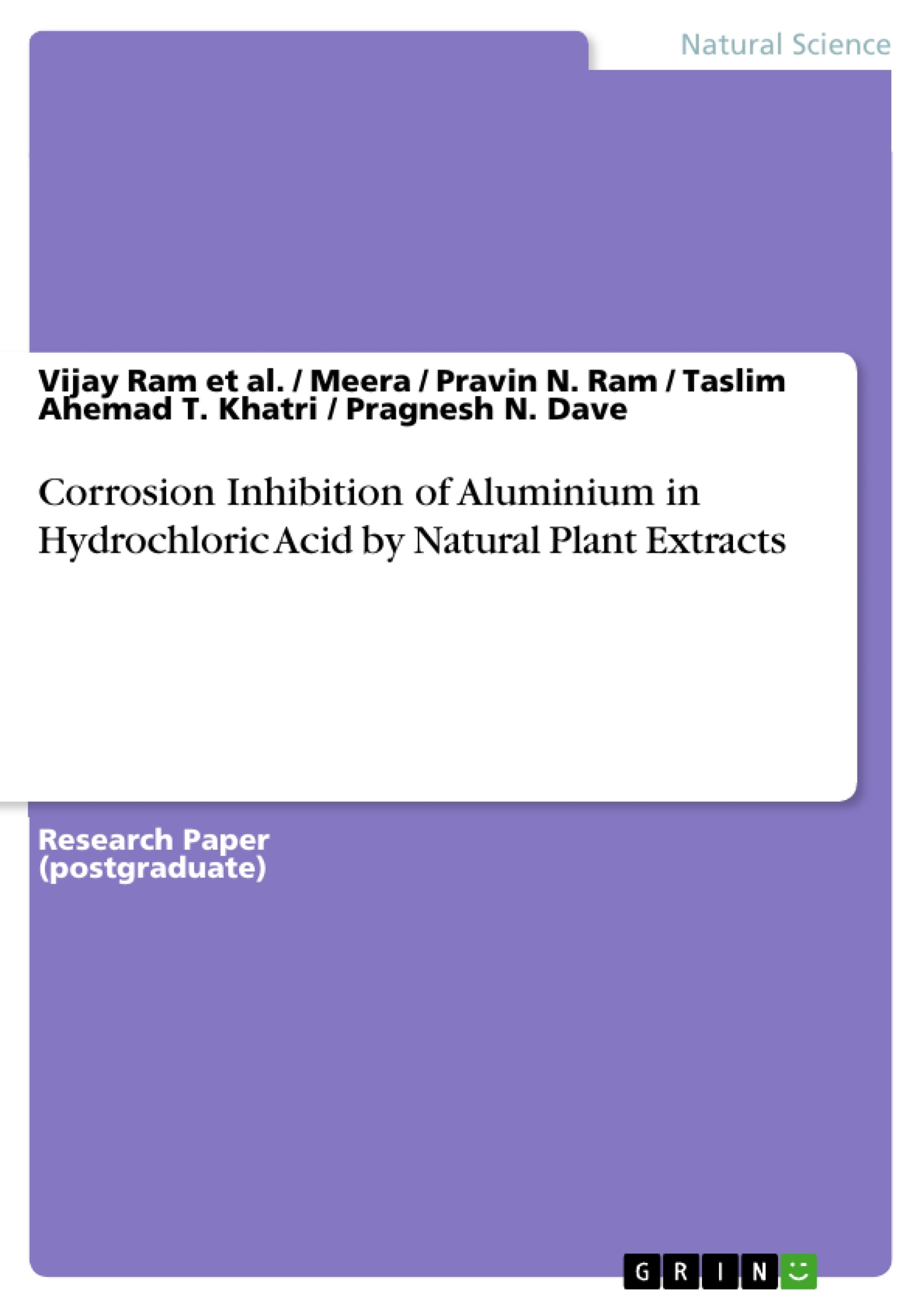Aluminium, being a highly reactive metal, corrodes rapidly in acidic (pH < 6) and alkaline (pH > 12.5) media. Hence it has to be protected when it is likely to come in contact with such solutions, e.g., during cleaning or acid pickling. One method of protection is the addition of inhibitor to the corroding medium. In the present work, ethanol extract of Azadirechta indica and Murraya koenigii leaves have been investigated as corrosion inhibitor for aluminium in aqueous hydrochloric acid.
The corrosion of Alluminium in plain hydrochloric acid, as well as inhibited, is found to increase with a rise in temperature. Thus in uninhibited 0.5 M HCl the loss in weight due to corrosion for an exposure period of 60 min increases from 736 mg/dm2 at 35oC to 852, 922, and 958 mg/dm2 at 45oC, 55oC and 65oC respectively.
In inhibited 0.5 M HCl containing 1.30% of Azadirechta indica, it was observed that at 35oC and for an exposure period of 60 min Azadirechta indica confer 100.0% protection. In A. indica, it is observed that the compound at 1.30% concentration show an efficiency 100.0% at 35°C. As the temperature is increased the efficiency decreases. In the case of A.indica, the efficiency decreases slightly and is found to be 72.96% at 65°C. It appears that in the case of Azadirechta indica, the adsorption is of physisorption type which decreases with a rise in temperature.
The surface morphology of the Al samples in the absence and presence of A.indica and M.koenigii leaves extract was investigated after weight loss using SEM technique. The badly damaged surface obtained when the metal was kept immersed in 0. 5 M HCl for 60 min without inhibitor indicates significant corrosion. However, in presence of inhibitor the surface has remarkably Improve with respect to its smoothness indicating considerable reduction of corrosion rate. This improvement in surface morphology is due to the formation of a good protective film of inhibitor on aluminium surface which is responsible for inhibition of corrosion. The order of efficiency at 1.30% v/v inhibitor concentration in 0.5 M hydrochloric acid was found to be : Azadirechta indica (100.0%) Murraya koenigii ( 94.79%)
Inhaltsverzeichnis (Table of Contents)
- Chapter-1. Introduction of corrosion
- 1.1 General Aspect of Corrosion
- 1.2 Factors Influencing Corrosion
- 1.3 Types of Corrosion
- 1.4 Aim of Research work
- 1.5 References
- Chapter -2. Performance and Impact of plant extracts as Metallic Corrosion Inhibitors
- 2.1 Plant extract as Corrosion Inhibitors
- 2.2 Effect of Functional Group on Inhibitors
- 2.3 Classification of Inhibitors
- 2.4 Phenomenon of Adsorption
- 2.5Azadirechtaindica utilized in the present work its properties And uses as corrosion inhibitor
- 2.6Murrayakoenigii utilized in the present work its properties And uses as corrosion inhibitor
- 2.7References
- Chapter -3.Spectral studies on plants use as green inhibitor
- 3.1 Infrared spectroscopy
- 3.2 X-ray fiuoresence study
- 3.3 References
- Chapter -4. Experimental Methods and Discussion of the Results
- 4.1 Experimental Method
- 4.2 Preparation of plant extract
- 4.3 Discussion of the Results
- 4.4 Effect of Inhibitor Concentration
- 4.5 Effect of Exposure Period
- 4.6 Effect of Temperature
- 4.7 Scanning electron microscopic study
- 4.8 References
- Chapter -5. Summary of the Dissertation
- 5.1 Effect of Inhibitor Concentration
- 5.2 Effect of Exposure Period
- 5.3 Effect of Temperature
- 5.4 Scanning electron microscopic study
Zielsetzung und Themenschwerpunkte (Objectives and Key Themes)
This research investigates the effectiveness of natural plant extracts as corrosion inhibitors for aluminum in hydrochloric acid. The study aims to understand the impact of different factors, such as inhibitor concentration, exposure time, and temperature, on the corrosion process.- The efficacy of plant extracts as corrosion inhibitors.
- The role of inhibitor concentration, exposure time, and temperature in influencing corrosion.
- The mechanism of corrosion inhibition by plant extracts.
- The potential applications of plant extracts in corrosion prevention.
Zusammenfassung der Kapitel (Chapter Summaries)
- Chapter 1: Introduction of Corrosion: This chapter provides a comprehensive overview of corrosion, including its general aspects, factors influencing it, and different types of corrosion. It also states the aim of the research work.
- Chapter 2: Performance and Impact of plant extracts as Metallic Corrosion Inhibitors: This chapter explores the use of plant extracts as corrosion inhibitors. It discusses the classification of inhibitors, the phenomenon of adsorption, and the properties and uses of Azadirechta indica and Murraya koenigii as corrosion inhibitors.
- Chapter 3: Spectral studies on plants use as green inhibitor: This chapter focuses on spectral studies using techniques like Infrared spectroscopy and X-ray fluorescence to analyze the plant extracts utilized as inhibitors.
- Chapter 4: Experimental Methods and Discussion of the Results: This chapter details the experimental methods used in the study, including the preparation of plant extracts. It then discusses the results obtained, analyzing the effects of inhibitor concentration, exposure time, and temperature on corrosion.
Schlüsselwörter (Keywords)
This research focuses on the corrosion inhibition of aluminum in hydrochloric acid using natural plant extracts. The study explores the effects of inhibitor concentration, exposure period, and temperature on the corrosion process. Key terms include corrosion inhibition, plant extracts, aluminum, hydrochloric acid, Azadirechta indica, Murraya koenigii, weight loss method, spectral studies, infrared spectroscopy, and X-ray fluorescence.- Quote paper
- Dr. Vijay Ram et al. (Author), Meera (Author), Pravin N. Ram (Author), Dr. Taslim Ahemad T. Khatri (Author), Dr. Pragnesh N. Dave (Author), 2014, Corrosion Inhibition of Aluminium in Hydrochloric Acid by Natural Plant Extracts, Munich, GRIN Verlag, https://www.grin.com/document/279280



